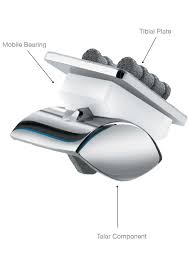FFLC TOTAL ANKLE REPLACEMENT (STAR)
August 16 2018
Scandinavian Total Ankle Replacement (STAR)
The STAR implant is the only FDA approved mobile-bearing TAR and is approved to be used without bone cement. These features have allowed for shorter operating times, quicker recovery, and 10-year survival rates greater than 90%. New soft tissue dissertion technology has reduced soft tissue complications.
All treatment options will be discussed with the patient, so the appropriate procedure, or non-surgical approach, is chosen.
The evolution of the Total Ankle Replacement (TAR) began in the mid- 1970’s and progressed until the early 1990’s with the introduction of the Agility Ankle. Although it is no longer available, this implant paved the way for the new 2nd and 3rd generation implants used by lower extremity surgeons today.

The new 2nd and 3rd generation TAR devices are anatomic and stable, and duplicate normal ankle joint motion. In 2000, the Scandinavian Total Ankle Replacement (STAR) was approved by the FDA. The STAR is the only TAR that is mobile bearing and approved for use without bone cement.
These features have shown to provide a more natural ankle joint motion, including rotation of the leg, and a longer survival rate consistent with other joint replacement procedures.
More recently, the use of Plasma blade technology (when available) in conjunction with the STAR, has resulted in shorter operating times and less soft tissue complications.
All procedures are performed in either Collier or Lee county at hospitals that FFLC surgeons hold staff privleges. If you have any questions, or would like to schedule a patient consultation, please do not hesitate to contact us directly.
Who Are Candidates?
Although the indications continue to evolve, the ideal candidate is age 55 or older, 250 lbs. or less, and participates in low impact or sedentary activities. Low impact activities such as walking, hiking, and golfing are safe and permitted. Each patients circumstances are unique and reviewed during consultation.
What Is The Success Rate?
The current 3rd generation Total Ankle Replacements have demonstrated a 10 year survival rate of 94%.
How Difficult Is The Recovery?
The procedure is performed under general or spinal anesthesia. The patient is admitted the same day and can expect a 23 hour stay. Although each patient is different, recovery usually takes 6-8 weeks. The patient will begin protected partial weight bearing after 2 weeks and progress to full weight bearing at the beginning of the 5th week. A short course of Physical Therapy is necessary to accelerate recovery.
The procedure is covered by most insurance companies.
www.NaplesPodiatrist.com
239-430-3668 (FOOT)
Serving Southwest Florida Since 2005, Family Foot & Leg Center has 9 convenient locations throughout Collier, Lee, Charlotte, and Sarasota Counties. Offering pediatric to geriatric family care: Ingrown Toenails, Heel Pain, Bunions, Foot / Ankle Arthritis Pain, Plantar Fasciitis, Foot / Ankle Surgery, Custom Orthotics, and Diabetic Wound Care. In office X-rays, ultrasounds, and minor surgical suite exam rooms. Practice powered by EMR and advanced technologies. Home of the Lam Minimal Invasive No-Scar Bunion Surgery! Come Discover Why Patients Love Our 5-Star Foot & Ankle Care! Same Day Appointments! Easy Online Appointment Scheduling!

 Tel: 239-430-3668
Tel: 239-430-3668

